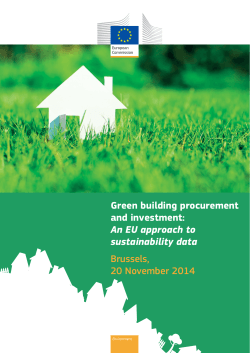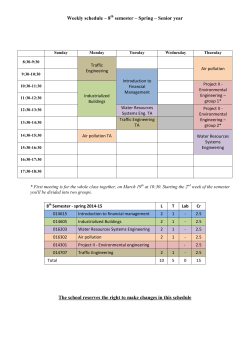
Linked Building Data for Information Modelling in Energy
ADAPT Undergraduate Students as Researchers Programme PROJECT DESCRIPTION Institution/Team: Project Title: Suitable for students who are studying in the following areas: Skills needed: Project Description: Kris McGlinn, Dave Lewis, Knowledge and Data Engineering Group, SWIMing project www.swiming-project.eu Linked Building Data for Information Modelling in Energy Efficient Buildings Linked Data, Building Information Modelling (BIM), Energy Efficient Buildings (EeB), Interoperability, Data Integration, Semantic Web Technologies. Self-motivated with strong programming skills. Experience with web technologies are required, familiarity with BIM and EeB are a plus; Energy efficiency has become an important topic due to the risks of rising levels of CO2 from burning fossil fuels, and the costs and security issues related to importing energy. By using energy more efficiently, Europeans can lower their energy bills, reduce their reliance on external suppliers of oil and gas and help protect the environment. In the EU, buildings are a major source of energy use, responsible for 40% of energy consumption and 36% of CO2 emissions. Methods which improve efficiency in buildings will therefore go towards reducing not only European energy consumption, but may also help reduce future energy needs across the world. Managing the large amounts of heterogeneous data generated throughout a buildings life cycle (BLC), which includes its design, construction and operation, and making it available to processes which manage a buildings energy consumption is a significant challenge. Building data (BD) can originate from sources as diverse as pdf and word documents, which describe building devices, to complex 2D and 3D models of the buildings geometry and materials, to data generated by building monitoring and control systems, which is stored in csv files or SQL databases, to data generated by building simulation tools, stored in proprietary formats. You will be working towards making this data accessible to tools and services along the BLC. This internship therefore represents an excellent opportunity to collaborate with world-class researchers in the study of building data management to support novel energy management processes. You will examine existing BD standards and semantic web technologies, in particular, Linked Data, as tools to support interoperability across the BLC. As an intern, you will meet with a wide variety of experts, attend workshops and summer schools, so that you may deepen your knowledge and improve your skills in a growing area of important research. Figure 1 Overview of BIM across BLC Energy Management The Role of the student & benefits gained from participation in this project: 1 Who will be working with you? Short description of the group: Recommended Reading Material: Your main role will be to examine existing building data models in the energy efficient building domain and look at the process of uplifting these data models to linked data. You will work closely with existing Energy Efficient Building (EeB) FP7 European projects, as well as the W3C Linked Building Data community group and BuildingSmart working group, examining use cases and determining which can best benefit from the LD approach. You will also become skilled working with Linked Data technologies, for example, making use of a Fuseki RDF server to upload ifcOWL, and SPARQL queries to map data models to ifcOWL concepts. In this capacity, you will work towards the development of a methodology for uplifting existing building data models to this and other relevant knowledge representations. You may also be required to do some development on client side web apps to support this process using, for example, HTML5 technologies. You will be working closely with Dr. Kris McGlinn, PI for the SWIMing project – www.swimingproject.eu You will also have support from Prof. Dave Lewis, who has worked on similar projects: Lider and PI for Falcon, in the multilingual domain, and who is also an integral part of the ADAPT Centre. Dr. Kris McGlinn, PI for the SWIMing project. Prof. Dave Lewis, Director of the Knowledge and Data Engineering Group (KDEG) www.swiming-project.eu https://www.w3.org/community/lbd/ http://linkedbuildingdata.net/ Relationships-Between-Linked-Open-Data-and-BIM http://www.coventry.ac.uk/Global/Faculty%20events/SB13/SB13-19-Relationships-Between-LinkedOpen-Data-and-BIM.pdf Building Optimisation using Linked Data https://www.deri.ie/sites/default/files/publications/curry_ldac_2012.pdf BIM handbook: A guide to building information modeling for owners, managers, designers, engineers and contractors - Chuck Eastman et al. Other information: For further details on this project please contact: 1 Name: Phone: E-Mail: Website: Kris McGlinn 086 054 9342 Kris.McGlinn@scss.tcd.ie www.swiming-project.eu This is an initial description of the role of the student and it is liable to change following discussions between the investigators and the student.
© Copyright 2025
















